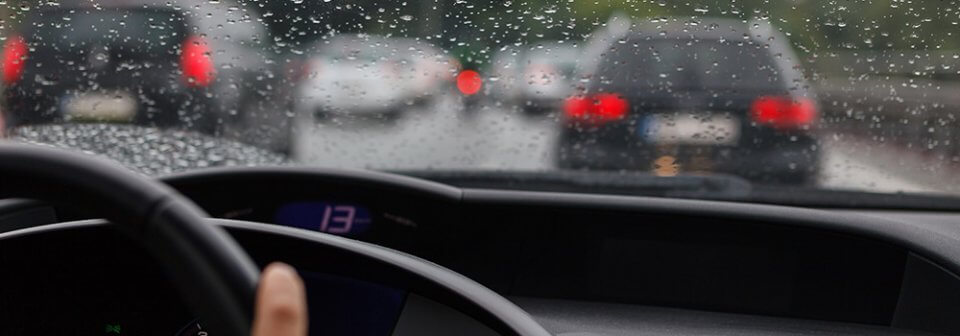
Driving in rainy conditions can be a challenge for many drivers, especially when heavy rain starts to pour.
It can reduce visibility, making it difficult to see the slick roads ahead, and increase the risk of accidents that can result in costly auto insurance claims. The steering wheel can also become more difficult to turn in heavy rain, making it important to maintain a good grip.
Why Safe Driving in Wet Weather is a Must
Safe driving in wet weather is a must because wet pavement increases the risk of hydroplaning, decreases visibility, and makes driving uncomfortable. In addition to checking your vehicle’s condition and ensuring that everything is in good working order, the best thing you can do is exercise caution and take precautions.
Maintaining a safe following distance, avoiding large puddles, and driving at slower speeds are some of the best ways to stay safe on your journey. A car accident is always a risk in wet conditions, but by taking the first step of preparing your vehicle and driving with care, you can reduce that risk significantly.
Driving safely in the rain requires diligence, but the following safe driving tips will make you more prepared for driving on wet road conditions.
1. Slow Down
Many people believe that they can maintain the same speed in the rain as they would on a sunny day. The reality is that when the roads are wet, you are much more likely to lose control of your vehicle. Hydroplaning is a dangerous situation that can occur when your tires are raised up above the pavement and ride on top of a layer of water, and slowing down is the only sure-fire way to prevent it. It can happen in as little as 1/12 of an inch of water, so don’t assume that it won’t happen in a light rain.
If you ever do hydroplane, being able to recover safely is an essential rainy weather skill. Here’s how to do it:
- Get your foot off the gas. Don’t ever use your brakes, as tempting as this may be, as it could cause you to skid and completely lose control of the vehicle.
- Turn your wheel in the direction the car is moving. This might feel counter-intuitive, but it makes it much easier to regain control of your car.
- Hold it until your wheels are back on solid ground. You’ll be able to tell immediately.
- Now that you’ve recovered, if you’re feeling a little rattled by this experience, pull over and relax for a minute.
2. Leave Room
One of the most important driving tips we can offer is to leave more space between your car and the one in front of you in wet conditions. The distance it takes to stop doubles in the rain so it is important to adjust. Keep your distance and drive safe.
3. Turn on Your Lights
In the rain, lights help you to see and be seen. Visibility is significantly lower, so your headlights are essential for other drivers to see you coming. Unlike some rainy weather safety tips, this one is required by law in most states.
When visibility is low, as it usually is when it rains, all states require your headlights to be on, and many require them to be on whenever the wipers are on. Regardless of the rules in your state, make it a habit – when you turn on your wipers, turn on the lights.
4. Replace Your Wiper Blades
This one’s simple enough, but it’s also easy to procrastinate. It’s a good idea to replace them annually before the rain starts, but if your wipers don’t wipe the windshield clean in one swipe, it’s time to replace them regardless. Most oil change places can replace them for you, to keep things simple, or you can save a few bucks by doing it yourself. Either way, don’t neglect this important tip.
5. Forget About Cruise Control
Cruise control is convenient in good weather, especially on long open stretches of highway. In the rain, though, you’ll often need to let off the accelerator quickly to keep from hydroplaning or skidding. Not only that, but if your car does hydroplane, cruise control might actually cause your vehicle to accelerate – exactly opposite to what you want.
What is OSHA’s Stance on Working in the Rain?
OSHA recommends that employees who work outdoors in inclement weather, including rain, ensure that their vehicles and equipment are in good condition before beginning work. They also suggest that workers plan their route ahead of time and avoid areas with poor drainage, flooding, or reduced visibility.
In addition, OSHA encourages the use of common sense when working in the rain, such as finding a safe spot to pull over if driving becomes uncomfortable or unsafe. Overall, taking precautions and being prepared is the best way to stay safe when working in rainy conditions.
Stay Safe on the Road
In bad weather, cars can become difficult to control – this you know. If you follow these wet weather driving safety tips, you’ll help to keep your car in control, and to keep the roads safer. While accidents can still happen, you are much less likely to cause them.
Now that you have the tips you need to drive safely in the rain, why not request a quote to find out how much money you can save on car insurance. Get a free car insurance quote online or by calling 877-435-3177.



